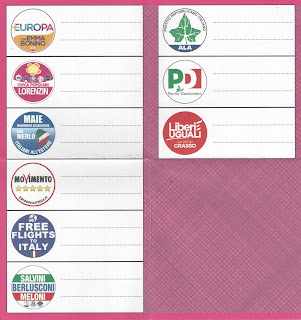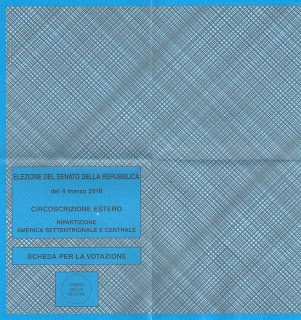Overview
Italy is holding a general election on March 4, 2018. How and
why this has come to be is better left to those more able to explain the
situation than I: see, for example, Italian
general election, 2018, Italy dissolves parliament
for March election, and Paolo
Gentiloni to succeed Matteo Renzi as Italian prime minister to see why the government
was dissolved. Up for grabs in this election are 315 seats in the Italian
Senate (Senato) and 630 seats in the Chamber of Deputies (Camera dei deputati), which is pretty much everything. So
much for easing in change.


Fun with the 2018 Italian political party symbols (insignia). Represented here are about 40 symbols.


Fun with the 2018 Italian political party symbols (insignia). Represented here are about 40 symbols.
Observations
Origins of the election aside, there are several confusing
aspects we'd like to mention as seen by folks "outside"
the system.
The first confusing
aspect is the sheer number of parties in this election.
I lost track after counting over 30 parties registered. Wired.it
reports 98 parties. Even though not all parties may be on the ballot (la scheda elettorale)
for a given citizen in a given location, the choices are nonetheless
overwhelming. At least, I think so. And, boy do Italians, err, I mean political
parties love their symbols. It took me a couple of hours to line up all the round colorful symbols (insignia) and understand who and what ideas were behind each one. More
on symbols is discussed below.
The second confusing
aspect of this election is the process for voting.
This election is the first test of
a new electoral law passed in 2017 called Rosatellum
bis. In this law, 36% of the seats of both the Senate and Chamber of
Deputies are allocated to candidates who receive the most votes, or winner takes
all (collegi uninominali). The remaining 64% of the seats in both
bodies are awarded proportionally to parties (collegi plurinominali) based on the votes received by each party.
On the ballot, winner takes all and proportional system are combined in such a
way that there are a couple of ways you can vote. As explained in the Wikipedia
article on this election, you can:
I. Select a candidate representing a constituency AND select a party that supports him (there may be multiple because the candidate may be in coalition with different parties). Therefore, you make two X marks on your ballot.
II. Select just a party. In this case, your vote extends to a candidate in coalition with the party.
III. Select just a candidate representing a constituency. In this case, your vote is proportionally extended to those parties supporting the candidate.
Diagrams of how this looks on
ballots is shown here in Today.it;
though written in Italian, the link's images get the point across about the different
choices and their implications. Some commentators are warning that voting
as described in I. above is the only way to ensure your vote goes to who you intended.
Our ballots (shown below) are simpler than you'd find in Italy because they do not contain coalitions (coalizioni), and as far as we can tell, we just write our candidate's names next to the party they are associated with as well as draw an X on the party. You can find the list of candidates for overseas voters online at the Dipartimento per gli Affari Interni e Territoriali - Elezioni trasparenti site, under Circoscrizioni Estero. For Italians in North and Central American, the We the Italians site gives a nice overview of the choices of candidates and parties.
Our ballots (shown below) are simpler than you'd find in Italy because they do not contain coalitions (coalizioni), and as far as we can tell, we just write our candidate's names next to the party they are associated with as well as draw an X on the party. You can find the list of candidates for overseas voters online at the Dipartimento per gli Affari Interni e Territoriali - Elezioni trasparenti site, under Circoscrizioni Estero. For Italians in North and Central American, the We the Italians site gives a nice overview of the choices of candidates and parties.
Finally, the third
confusing aspect, yet also interesting, is the
existence of parties and platforms focused on concerns specific to Italians living outside
the country.
We are not used to thinking about the voting block outside of a country. Let's back up for a second and
review the Italian voting system. Italians residing overseas (all'estero) are part of a "territory"
(circoscrizione estero) that is in turn broken into four
subdivisions (quattro ripartizioni): Europe, including the Asian territories
of the Russian Federation and Turkey; South America; North and Central America;
and Africa, Asia, Australia and Antarctic. Each subdivision has different
parties and candidates on the ballot. Of
the seats in this general election, 6 of 315 seats of the Senate and 12 of the
630 Chamber seats will be elected by Italians abroad.
In the North and Central America ripartizione,
we have – at time of writing this - two parties which from their names are obviously focused on the concerns of
Italians living abroad: Associative
Movement Italians Abroad (MAIE) and the Free Flights to Italy (see Update below). Two of the items on MAIE's platform are, for example:
However, we also took a close look at all the candidates running under the Salvini-Berluconi-Meloni coalition - voting suggestions for mom not for us, I swear - and it was interesting to note that many of the candidates' platforms also made mention of IMU and healthcare as did MAIE. Many of the candidates representing voting blocks outside of Italy are tuned into their constituents. What a concept.
- Eliminating the IMU (Imposta Municipale Unica). From the MAIE site: " Italians living abroad, today pay the IMU tax on their home in Italy, due to the fact that it is not considered 'first home', an unjust discrimination that must be revoked."
- Extending healthcare to residents abroad. Again from the MAIE site: "Provide medical care to Italian residents abroad when they return temporarily to Italy. Italian citizens must have free access to the health care system in the country even if their residence is abroad."
However, we also took a close look at all the candidates running under the Salvini-Berluconi-Meloni coalition - voting suggestions for mom not for us, I swear - and it was interesting to note that many of the candidates' platforms also made mention of IMU and healthcare as did MAIE. Many of the candidates representing voting blocks outside of Italy are tuned into their constituents. What a concept.
Perhaps the focus on overseas voters is less surprising when we look at the numbers. Using figures from the Italian
Referendum of 2016 Numbers we can say that
- In Italy there were 46,720,943 voters.
- Outside of Italy there were 4,052,341 voters. (This source gives a 4.3 million count of abroad voters.)
- Together, these numbers indicate that about 9% of Italian voters live outside of Italy.
By comparison, there are about 9 million US
citizens living abroad. With an estimated total USA population in
2016 of 321 million, we can estimate that about 3% of US citizens live outside
the USA. Given the higher percentage of Italians abroad, it's fair to say that
they represent an important voting block and, therefore, it makes some sense
that there are specialized parties tailored to their concerns. But, really,
free flights? Apparently no, see Update below.
Vocabulary and Grammar
Rather than tell you who to vote for, or who we voted for,
we'll take this opportunity to highlight some of the new vocabulary and grammar we've encountered.
Plico
A plico
is a group of papers or documents in a sealed envelope: a packet. In two
years studying the Italian language, this was the first time I ever encountered
this word. In our plico,
there is a sheet with instructions that include this:
All'interno del plico troverete
- 1 certificato elettorale
- 1 o 2 liste dei candidati
- 1 o 2 schede elettorali
- 2 buste, una piccola di norma di colore bianco e una più grande già affrancata con l'indirizzo del competente ufficio Consolare
- Il foglio informative.
This translates as: "Inside the packet you
will find 1 election certificate, 1 or 2 lists of candidates, 1 or 2 election
ballots, 2 envelopes, one small standard one (a security envelope) and one
larger one postage-paid envelope addressed to the consulate of jurisdiction,
and an instruction sheet."
Our plico
contained 2 lists of candidates and 2 associated ballots, one for the Senate and
one for the Chamber of Deputies. I'm not sure under what conditions a voter
would receive just one list of candidates or one ballot.
The certificate (certificato
elettorale) is a sheet of paper from which you tear off the bottom
part and send back with your ballot as proof that your vote is valid.


Left: Instructions for the March 2018 election. Right: A mailer received from a candidate running with the coalition Salvini-Berlusconi-Meloni (sounds like a repackaged version of spumone).
Contrassegni
Contrassegni are symbols that
represent each party. There are rules for the creation of an symbol, such as that the symbol can't make reference to fascist or Nazi or religious themes,
and it must be a circle. I immediately started wondering if they were always circles. It's seems
like a practical standardization. I looked around a bit for the history of
political symbols but couldn't find much by way of standardization or their history,
though I did stumble on to the site I
simboli della discordia ("the symbols of discord"), which thoroughly describes this election's political symbols (in Italian).
Some symbols contain other symbols (pulce)
of parties in a sort of coalition. Examples of the ballots we received which have
these are Civica Poplare or Salvini-Berlusconi-Meloni.
Slogans
Below are some of the slogans we could find for the parties we had
on our ballot. We couldn't find a well-defined slogan for MAIE, Partito Repubblicano, or Free Flights.
Though Free Flights (see Update below) does make liberal use of "Time to Say Goodbye"
(Con Te Partirò) by Sarah Brightman and Andrea Bocelli, which could sort of be counted as a slogan?
- Avanti, Insieme – "Forward, together" [Partito Democratico, PD]
- Per i molti, non per i pochi – "For the many, not the few" [Liberi e Uguali, LeU]
- Onestà, Esperienza, Saggezza – "Honesty, Experience, Wisdom" [Forza Italia, FI]*
- Più Europa, serve all'Italia – "More Europe, Italy needs it" [Più Europa, +E]
- Il vaccino control gli incompetenti – "The vaccine against incompetents" [Civica Popolare, CP]
* This slogan requires a comment. Experience okay, wisdom maybe, but honesty after everything that has come out about Berlusconi?
Campaign Mailers
We received five campaign mailings. One from a MAIE
candidate and four from Salvini-Berlusconi-Meloni (S-B-M) candidates. For educational
purposes, let's look at one from the S-B-M camp, from Senate candidate
Francesca Alderisi. She writes:
Adesso sta a
te fare la TUA scelta. Scegli con la testa. Scegli con il cuore! –
"Now it's up to you to choose. Choose with your head. Choose with your
heart!"






Just finished my ballot and have it ready for the mail. Thanks for the excellent post- extremely helpful!
ReplyDelete